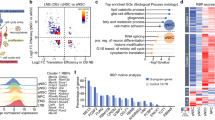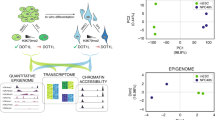Abstract
Medulloblastoma is the most malignant pediatric brain tumor. It is believed to originate from the undifferentiated external granule layer cells in the cerebellum, but the mechanism of tumorigenesis remains unknown1,2,3,4,5,6. Here we studied three types of human medulloblastoma cells that express markers corresponding to different levels of neuronal differentiation. They expressed the neuronal repressor element 1 (RE1) silencing transcription factor/neuron-restrictive silencer factor (REST/NRSF; refs. 7–10) at very high levels compared with either neuronal progenitor NTera2 (NT2) cells or fully differentiated human neuron teratocarcinoma (hNT cells). To counter the effect of REST/NRSF, we used a recombinant transcription factor, REST–VP16, constructed by replacing repressor domains of REST/NRSF with the activation domain of viral protein (VP16). Transient expression of REST–VP16 in medulloblastoma cells was able to compete with the endogenous REST/NRSF for DNA binding and stimulate neuronal promoters. High-efficiency expression of REST–VP16 mediated by adenovirus vectors (Ad.REST–VP16) in medulloblastoma cells was able to counter REST/NRSF-mediated repression of neuronal promoters, stimulate expression of endogenous neuronal genes and trigger apoptosis through the activation of caspase cascades. Furthermore, intratumoral injection of Ad.REST–VP16 in established medulloblastoma tumors in nude mice inhibited their growth. Therefore, REST/NRSF may serve as a new target for therapeutic interventions for medulloblastoma through agents such as REST–VP16.
This is a preview of subscription content, access via your institution
Access options
Subscribe to this journal
Receive 12 print issues and online access
$209.00 per year
only $17.42 per issue
Buy this article
- Purchase on Springer Link
- Instant access to full article PDF
Prices may be subject to local taxes which are calculated during checkout




Similar content being viewed by others
References
Fuller, G.N. in Pediatric Neoplasia: Morphology and Biology (ed. David M. Parham) 153–204 (Lippincott-Ravel, Philadelphia, 1996).
Provias, J.P., and Becker, L. E. Cellular and molecular pathology of medulloblastoma. J. Neurooncol. 29, 35 –43 (1996).
He, X.M. et al. Phenotypic analysis of four human medulloblastoma cell lines and transplantable xenografts. J. Neuropathol. Exp. Neurol. 48, 48–68 (1989).
Whelan, H.T., Krouwer, H.G., Schmidt, M.H., Reichert, K.W. & Kovnar, E.H. Current therapy and new perspectives in the treatment of medulloblastoma. Pediatr. Neurol. 18, 103–115 (1998).
Goussia, A.C., Bruner, J.M., Kyritsis, A.P., Agnantis, N.K. & Fuller, G.N. Cytogenetic and molecular genetic abnormalities in primitive neuroectodermal tumors of the central nervous system . Anticancer Res. 20, 65– 74 (2000).
Adesina, A.M., Nalbantoglu, J. & Cavenee, W.K. p53 gene mutation and mdm2 gene amplification are uncommon in medulloblastoma. Cancer Res. 54, 5649–5651 (1994).
Chong, J.A. et al. REST: a mammalian silencer protein that restricts sodium channel gene expression to neurons. Cell 80, 949 –957 (1995).
Schoenherr, C.J. & Anderson, D.J. The neuron-restrictive silencer factor (NRSF): a coordinate repressor of multiple neuron-specific genes. Science 267, 1360– 1363 (1995).
Schoenherr, C.J., Paquette, A.J. & Anderson, D.J. Identification of potential target genes for the neuron-restrictive silencer factor. Proc. Natl. Acad. Sci. USA 93, 9881–9886 (1996).
Tapia-Ramirez, J., Eggen, B.J., Peral-Rubio, M.J., Toledo-Aral, J.J. & Mandel, G. A single zinc finger motif in the silencing factor REST represses the neural-specific type II sodium channel promoter. Proc. Natl. Acad. Sci. USA 94, 1177–1182 (1997).
Tohyama, T. et al. Nestin expression in embryonic human neuroepithelium and in human neuroepithelial tumor cells. Lab. Invest. 66, 303–313 (1992).
Andres, M.E. et al. CoREST: a functional corepressor required for regulation of neural-specific gene expression. Proc. Natl. Acad. Sci. USA 96, 9873–9878 (1999).
Huang, Y., Meyers, S.J. & Dingledine . Transcriptional repression by REST: recruitment of Sin3A and histone deacetylase to neuronal genes. Nature Neurosci. 2, 867 –872 (1999).
Grimes, J.A. et al. The co-repressor mSin3A is a functional component of the REST–CoREST repressor complex. J. Biol. Chem. 31, 9461 –9467 (2000).
Majumder, S., Zhao, Z., Kaneko, K. & DePamphilis, M.L. Developmental acquisition of enhancer function requires a unique coactivator activity. EMBO J. 16, 1721–1731 ( 1997).
Chen, Z.F., Paquette, A.J. & Anderson, D.J. NRSF/REST is required in vivo for repression of multiple neuronal target genes during embryogenesis. Nature Genet. 20, 136–142 ( 1998).
Jacobsen, P.F., Jenkyn, D.J. & Papadimitriou, J.M. Establishment of a human medulloblastoma cell line and its heterotransplantation into nude mice. J. Neuropathol. Exp. Neurol. 44, 472–485 ( 1985).
Hollstein M., Sidransky, D., Vogelstein, B. & Harris, C.C. p53 mutations in human cancers. Science 253, 49–53 (1991).
Harris, C.C. Structure and function of the p53 tumor suppressor gene: clues for rational cancer therapeutic strategies. J. Natl. Cancer Inst. 88, 1442–1455 (1996)
Raffel, C., Thomas, G.A., Tishler, D.M., Lassoff, S. & Allen, J.C. Absence of p53 mutations in childhood central nervous system primitive neuroectodermal tumors. Neurosurgery 33, 301–306 ( 1993).
Xie, J. et al. Mutations of the PATCHED gene in several types of sporadic extracutaneous tumors. Cancer Res. 57, 2369– 2372 (1997).
Goodrich, L.V., Milenkovic, L., Higgins, K.M. & Scott, M.P. Altered neural cell fates and medulloblastoma in mouse patched mutants. Science 277, 1109–1113 ( 1997).
Perrimon, N. & McMahon, A.P. Negative feedback mechanisms and their roles during pattern formation. Cell 97, 13–16 (1999).
McMahon, A.P. More surprises in the hedgehog signaling pathway. Cell 100, 185–188 (2000).
Acknowledgements
We thank G. Mandel for her gift of pREST-Express, p73, pBS.REST and pSDK7; T. Kanda and G. Wahl for pH2BGFP-N1; C. Gomez-Manzano, J. Rossi, G. Lewandowicz and L. Wu for technical help, J.Yung for proof-reading and G. Mandeland G. Mandel and K. Smith for their comments. This work was supported in part by grants to S.M. from the Pediatric Brain Tumor Foundation of the United States and the National Institutes of Health (CA51255, GM53454). L.R. was supported by a Translational Research Award from the American Brain Tumor Association.
Author information
Authors and Affiliations
Corresponding author
Rights and permissions
About this article
Cite this article
Lawinger, P., Venugopal, R., Guo, ZS. et al. The neuronal repressor REST/NRSF is an essential regulator in medulloblastoma cells. Nat Med 6, 826–831 (2000). https://doi.org/10.1038/77565
Received:
Accepted:
Issue Date:
DOI: https://doi.org/10.1038/77565
This article is cited by
-
REST in the Road Map of Brain Development
Cellular and Molecular Neurobiology (2023)
-
Ubiquitin-specific peptidase 37: an important cog in the oncogenic machinery of cancerous cells
Journal of Experimental & Clinical Cancer Research (2021)
-
Difference of binding modes among three ligands to a receptor mSin3B corresponding to their inhibitory activities
Scientific Reports (2021)
-
Pharmacological inhibition of LSD1 activity blocks REST-dependent medulloblastoma cell migration
Cell Communication and Signaling (2018)
-
REST overexpression in mice causes deficits in spontaneous locomotion
Scientific Reports (2018)



